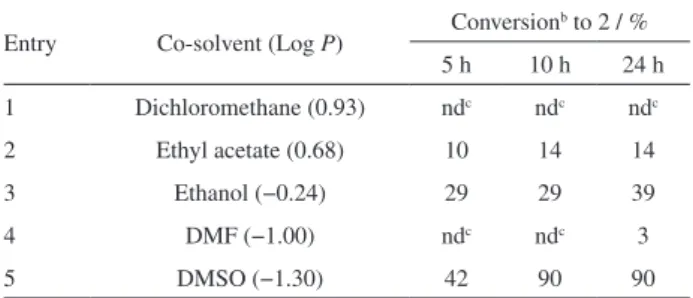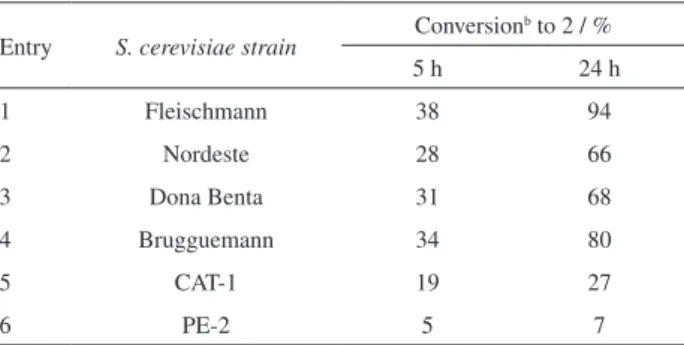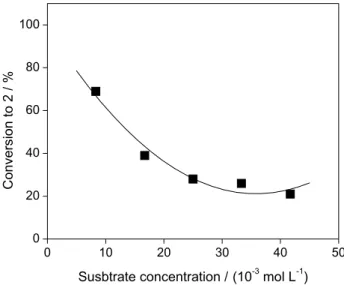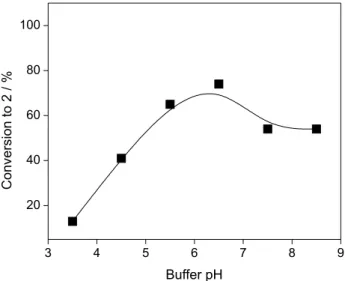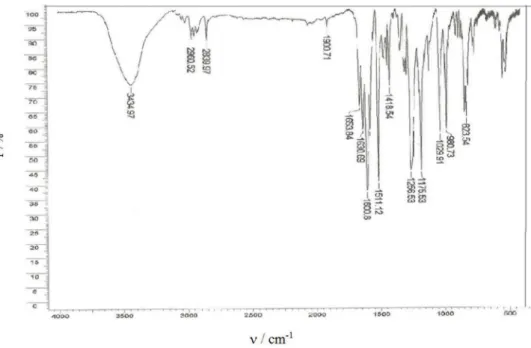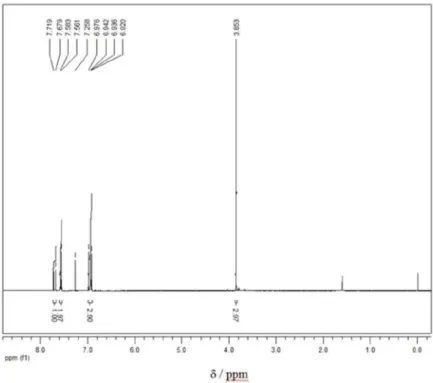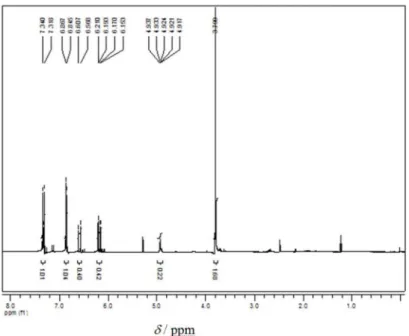Article
Printed in Brazil - ©2013 Sociedade Brasileira de Química0103 - 5053 $6.00+0.00
A
*e-mail: maria.nascimento@ufsc.br
Use of
Saccharomyces cerevisiae
Yeasts in the Chemoselective Bioreduction of
(1
E
,4
E
)-1,5-Bis(4-Methoxyphenyl)-1,4-Pentadien-3-one in Biphasic System
César A. Schaefer,a Vanessa D. Silva,a Boris U. Stambukb and Maria da G. Nascimento*,a
aDepartamento de Química and bDepartamento de Bioquímica,
Universidade Federal de Santa Catarina, 88040-900 Florianópolis-SC, Brazil
Este trabalho descreve a biorredução quimiosseletiva da (1E,4E )-1,5-bis(4-metoxifenil)-1,4-pentadien-3-ona (1) mediada por fermento de pão (BY, células de Saccharomyces cerevisiae) em sistema bifásico contendo água e n-hexano. A biotransformação deste composto foi quimiosseletiva, formando apenas a correspondente cetona saturada 1,5-bis(4-metoxifenil)-3-pentanona (2). Foi verificada a influência de vários fatores reacionais que podem afetar a biorredução de 1 tais como, tipo e porcentagem volumétrica do co-solvente, uso de seis diferentes leveduras S. cerevisiae (quatro comerciais e duas industriais), variação da concentração de substrato e levedura, temperatura, pH e volume das fases aquosa e orgânica. A melhor condição reacional foi obtida com 66,7 g L−1 de
BY da marca Fleischmann, 8,3 × 10−3 mol L−1 de substrato, pH de 6,5 a 35 oC na presença de 2,5%
(v/v) de N,N-dimetilsulfoxido (DMSO) como aditivo e razão Vaq/Vorg de 70/30. Nestas condições
o produto 2 foi obtido com conversão de 82% em 5 h de reação.
This work describes the chemoselective bioreduction of (1E,4E )-1,5-bis(4-methoxyphenyl)-1,4-pentadien-3-one (1) mediated by baker’s yeast (BY, Saccharomyces cerevisiae cells) in an aqueous/organic solventbiphasic system. The biotransformation of this compound was chemoselective and formed only the corresponding saturated ketone 1,5-bis(4-methoxyphenyl)-3-pentanone (2). The influence of various factors which may alter the bioreduction of 1, such as the type and percentage of co-solvents, use of six different S. cerevisiae yeast samples (four commercial and two industrial), variations in the substrate and yeast concentrations, temperature, pH and volume of aqueous and organic phases, was investigated. The best reaction conditions were 66.7 g L−1 of Fleischmann BY, 8.3 × 10−3 mol L−1 of substrate, pH 6.5 at 35 oC in the presence of
2.5% (v/v) of N,N-dimethyl sulfoxide (DMSO) as an additive and a Vaq/Vorg ratio of 70/30. Under
these conditions, the product 2 was recovered in conversions of 82% in 5 h reaction.
Keywords: Saccharomyces cerevisiae, α,β-unsaturated carbonyl compounds, bioreduction, biphasic system
Introduction
The use of whole cells or isolated enzymes in organic
chemistry to mediate the reduction of ketones, β-ketoesters,
imines and α,β-unsaturated systems with C=C activated
by strongly polarizing groups such as nitro, carbonyl or
hydroxyl groups is the subject of extensive study.1-6 It is
well known that biotransformation of an α,β-unsaturated
carbonyl compound in many cases gives a mixture of saturated ketone or aldehyde, saturated alcohol or allylic alcohol, indicating that several enzymes may catalyze the reduction of C=C and C=O double bond competitively. However many studies on the enantioselective reduction
of enones by biocatalysts have revealed that several enone reductases can be used for the production of chiral
ketones.7,8
Isolated enzymes frequently lead to higher enantiomeric
excesses (e.e.) since they avoid problems associated
with competing catalysts of different stereoselectivity. Unfortunately, reduced cofactors must be regenerated
in situ in a second catalytic cycle or provided in stoichiometric amounts to sustain the catalytic activity. Thus, the use of whole living cells is attractive since they do not require the addition of exogenous cofactors because of
their own cofactor regeneration systems.9-11 As an example,
Rhodotorula sp AS2.2241 has been used as a biocatalyst for the asymmetric reduction of 4’-methoxyacetophenone
several water-immiscible ionic liquids (ILs) have been
employed as green solvents.9 Also, biphasic
whole-cell biotransformations have been carried out for the asymmetric reduction of 4-chloroacetophenone to
(R)-1-(4-chlorophenyl)ethanol and of 2-octanone to
(R)-2-octanol. The evaluation of different hydrophobic
ionic liquids has also been carried out.10
Among the various possible biocatalysts, baker’s
yeast (S. cerevisiae) is perhaps the most well-known
whole-cell biocatalyst in the scientific and industrial world and is certainly the most commonly used yeast by organic chemists to mediate enantioselective reductions due to its high chemo-, regio- and enantioselectivity, high bioavailability, and ease of treatment and because it acts under mild reaction conditions. Microbial reactions are usually carried out in aqueous media where the cells are most active. Recently, the kinetics of the biotransformation
of geraniol into citronellol by resting cells of S. cerevisiae
(baker’s yeast type II) was investigated in a
continuous-closed-gas-loop bioreactor (CCGLB).12 Unfortunately,
many organic compounds of commercial interest which can potentially be transformed by enzymes or microorganisms are poorly soluble in this medium and display toxic effects on the biocatalyst. Thus, aqueous/organic solvent biphasic systems have been developed to overcome these limitations. These biphasic systems consist of an aqueous phase and a water immiscible organic phase where the microbial cells stay in the aqueous phase while the substrate and product(s)
remain mainly in the organic phase.13-14 The biphasic system
offers numerous advantages, such as increased solubility of hydrophobic substrates, smaller reaction volumes, increased volumetric productivity and minimization of substrate/product inhibition of the biocatalyst. Enzyme inhibition/inactivation by the solvents is minimized due to their low concentration in the aqueous phase, where the reaction takes place, and the recovery of the product
from the reaction medium is facilitated.11,15 Modifying the
reaction medium through the addition of water-miscible organic co-solvents is a method commonly used to improve the activity, selectivity and the stability of enzymatic
reactions.16-18 These co-solvents have the potential to
increase the activity by increasing the dissolution of poorly soluble substrates; however, in some cases they may inhibit the enzyme by changing its conformation through
denaturation.13,19
This paper reports a study on the baker’s yeast-catalyzed
bioreduction of an α,β-unsaturated carbonyl compound
(1E,4E)-1,5-bis(4-methoxyphenyl)-1,4-pentadien-3-one.
Firstly, the addition of various co-solvents to the buffer/n
-hexane biphasic systems was investigated to find the most appropriate organic solvent to solubilize the substrate.
Different strategies to improve the conversion into product, varying the substrate and yeast concentrations, temperature, pH, and volume of aqueous and organic phases, were also considered.
Experimental
Yeasts
Six S. cerevisiae yeast strains were used in their active dry yeast form. Four samples were commercial baker’s yeast (BY), named Fleischmann (AB Brasil Industria e Comércio de Alimentos LTDA, Brazil), Dona Benta (Pak Gida Uretim ve Pazarlam A. S., Turkey), Nordeste (Moinho do Nordeste S.A., Brazil) and Brugguemann (Algist Bruggeman NV, Belgium), and two were industrial yeast strains (CAT-1 and PE-2) which are currently used for ethanol production
in Brazil.20,21 These two industrial fuel ethanol yeasts have
been commercially available since the late 1990s, and are
distributed by LNF Latino Americana Ltda. from Brazil.22
The pellets of dehydrated yeast cells were used directly in the reduction reactions as described below.
Materials
The following chemicals were used as received: potassium phosphate buffer purchased from Vetec; citric acid from Acros; sodium hydroxide from Grupo Química; acetone (99.5%) from Merck; 4-methoxybenzaldehyde (98%) and silica gel (70-230 mesh) from Sigma Aldrich; sodium borohydride (98%) from Merck; and deuterium chloroform (99.8%) from Cambridge Isotope Laboratories. All organic solvents were obtained from commercial sources and were of analytical grade.
General procedure for the bioreduction reactions employing yeasts
In a typical experiment, a mixture of 30 mL of n-hexane
containing 290 mg of 1, 4 g of BY and 30 mL potassium
phosphate/citric acid buffer was incubated at 35 ºC in 250 mL Erlenmeyer flasks with magnetic stirring. Aliquots were periodically withdrawn from the aqueous and organic phases and extracted with dichloromethane (2 × 10 mL).
The organic phase was combined, dried with MgSO4 and
the solvent was removed under vacuum. The residue was analyzed by GC to evaluate the percentage of conversion to product. Substrate and product peak areas were compared, and the sum of the two was considered as 100%. After the
bioreduction of 1 with BY, the product 2 was isolated and
Details regarding the co-solvents, co-solvent percentage (%), substrate and yeast concentrations, buffer pH, temperature, and volumetric percentage of organic phase are specified for each assay in the results and discussion section.
Analytical methods
Proton nuclear magnetic resonance (1H NMR) 400 MHz
was carried out on a Varian 400 Mercury Plus spectrometer
using CDCl3 as the solvent and tetramethyl silane (TMS)
as the internal standard. Infrared spectra (IR) were acquired with an ABB Boomer FTLA 2000-100 spectrometer using
KBr pellets (range 4000-400 cm−1) at the Center of Analysis,
Department of Chemistry, UFSC (Florianópolis-SC, Brazil). Gas chromatography (GC) analysis was carried out with a Agilent 78202A GC-instrument equipped with an FID detector, using hydrogen as the carrier gas (19,84 psi), equipped with a Shimadzu CBP5 column
(25m × 0.22 mm × 0.25 mm). The injectorand detector
temperatures were 280 and 290 ºC, respectively, and the column temperature was 250 ºC. The retention times observed
for 1, 2 and 3 were 12.5, 4.1 and 5.1 min, respectively. In
the thin-layer chromatography (TLC) n-hexane:ethyl acetate
(8:2 v/v) was used as the eluent.
Results and Discussion
In the first step of this study, (1E,4E
)-1,5-bis(4-methoxyphenyl)-1,4-pentadien-3-one (1) was synthesized
by the aldol condensation reaction between the 4-methoxybenzaldehyde and acetone under basic conditions. This compound was used as a substrate in the
bioreduction reaction using S. cerevisiae cells in aqueous/
organic solvent biphasic systems formed with n-hexane
and potassium phosphate/citric acid buffer. The selection
of n-hexane as the organic solvent was based on previous
results obtained in the biohydrogenation of (2E
)-1,3-diaryl-2-propen-1-ones catalyzed by S. cerevisiae yeast.23
The biocatalytic reduction of 1 by BY was completely
chemoselective, producing only the corresponding saturated
ketone 1,5-bis(4-methoxyphenyl)-3-pentanone (2)
(Scheme 1). The alcohol (1E,4E
)-1,5-bis(4-metoxyphenyl)-1,4-pentadien-3-ol (3) was not detected in any experiments,
and this finding was confirmed by comparison of the
retention times (Rt) obtained from the analysis of 1, 2
and 3 by gas chromatography (GC), which were 12.5, 4.1
and 5.1 min, respectively. The structure of compound 2,
obtained in the bioreduction reaction, was confirmed by
IR and 1H NMR spectral analysis, as described in the
experimental section.
After the spectroscopic identification of the product
obtained in the bioreduction of 1 with S. cerevisiae yeast
in the buffer/n-hexane biphasic system, the influence of
various factors which may influence this reaction was investigated, as shown in the following sections.
Effect of addition of co-solvents and DMSO percentage
Since the substrate is not totally soluble in the media
used to study the bioreduction of 1 catalyzed by BY in
buffer/n-hexane biphasic systems, the influence of the
addition of several co-solvents in the reaction medium, such as dichloromethane, ethanol, ethyl acetate, DMSO
and N,N-dimethylformamide (DMF), was evaluated. The
conversions to 2, as a function of the co-solvents added and
the reaction time, are presented in Table 1.
As observed in Table 1, when ethyl acetate and ethanol were used as co-solvents the conversions were between 10-39% and were influenced by the reaction time (Table 1, entries 2 and 3). On using dichloromethane or DMF no product was detected in 10 h of reaction, and with the use
Scheme 1. Biotransformation of (1E,4E)-1,5-bis(4-methoxyphenyl)-1,4-pentadien-3-one catalyzed by S. cerevisiae yeasts in a biphasic system.
Table 1. Effect of co-solvent on the bioreduction of 1 catalyzed by baker’s yeast in buffer/n-hexane biphasic systema
Entry Co-solvent (Log P) Conversion b to 2 / %
5 h 10 h 24 h
1 Dichloromethane (0.93) ndc ndc ndc
2 Ethyl acetate (0.68) 10 14 14
3 Ethanol (−0.24) 29 29 39
4 DMF (−1.00) ndc ndc 3
5 DMSO (−1.30) 42 90 90
Table 2. Screening of yeast strains for the bioreduction of 1 in buffer/n -hexane biphasic system with addition of DMSO
Entry S. cerevisiae strain
Conversionb to 2 / %
5 h 24 h
1 Fleischmann 38 94
2 Nordeste 28 66
3 Dona Benta 31 68
4 Brugguemann 34 80
5 CAT-1 19 27
6 PE-2 5 7
aReaction conditions: dry yeast (4 g), substrate (290 mg), 0.2 mol L-1 potassium phosphate/0.1 mol L-1 citric acid buffer (pH 5.5) (30 mL),
n-hexane (28.5 mL), 2.5% (v/v) DMSO (1.5 mL), 35 ºC. bThe conversion values were determined by GC.
of DMF the conversion was only < 5% in 24 h of reaction (Table 1, entries 1 and 4). Better results were achieved with DMSO as the co-solvent, presenting conversions of 42, 90 and 90% in 5, 10 and 24 h of reaction, respectively (Table 1, entry 5). However, no direct relationship with the organic
solvent polarity (expressed by Log P values) was observed.
These results indicate that DMSO was the most suitable
co-solvent for the biosynthesis of 2 in a buffer/n-hexane
biphasic system. Thus, the effect of varying the percentage of this co-solvent from 2.5% to 15% (v/v) was examined in 5 h of reaction. Higher percentages of DMSO were not feasible due to an increase in the reaction viscosity and experimental problems in the reaction work up, related to the reactant and product isolation. With the use of DMSO percentages of 2.5, 5, 9 and 15% the conversions were 38, 47, 42 and 38%, respectively, showing no significant changes as different quantities of DMSO were added to the reaction medium.
In several studies reported in the literature it was found that the addition of DMSO to the reaction medium leads to an increase in the conversion into products, as well as
in the selectivity of reaction.24-26 In addition, the solvent
toxicity must be considered and DMSO is well recognized as being non-toxic toward certain cells and can be used as
a cryoprotectant, depending on its final concentration.27-29
For example, Wang et al.26 reported that the reduction of
acenaphthenequinone using baker’s yeast in a monophasic system provides an improvement in the conversion to the mono-alcohol 2-hydroxyacenaphthenones with the addition of 10% (v/v) DMF and DMSO as co-solvents, with conversions increasing from 72% to 97% and 98%, respectively. Thus, considering the above results, 2.5% (v/v) DMSO was used as the solvent in the subsequent experiments.
Screening of yeasts
In the next study, six different S. cerevisiae strains,
four commercial (Fleischmann, Nordeste, Dona Benta and Brugguemann) and two industrial (CAT-1 and PE-2) were screened in order to identify which yeast strain was
the most efficient in the bioreduction of (1E,4E
)-1,5-bis(4-methoxyphenyl)-1,4-pentadien-3-one in a biphasic system (Table 2).
As observed in Table 2, the conversion to product was strongly influenced by the use of different BY and reaction times. When the reaction was carried out for 5 h, no significant differences in the conversions were observed using the commercial yeasts named Fleischmann, Nordeste, Dona Benta and Brugguemann, the values obtained being 38, 28, 31 and 34%, respectively.
However, when the bioreduction was carried with 24 h of reaction, the commercial BY from Fleischmann was the
most efficient biocatalyst and the product 2 was obtained
in a conversion of 94%. Low conversions to 2 (5 to 27%)
were obtained when the industrial yeast samples CAT-1 and PE-2 were employed in 5 and 24 h of reaction. These were unexpected results considering that when these yeasts were used in the biohydrogenation of chalcones the conversions were similar to those obtained with BY
from Fleischmann.23 Based on these data, the commercial
BY from Fleischmann was selected as the biocatalyst for the subsequent experiments.
Effect of BY concentration
An optimum yeast concentration is an important experimental parameter in terms of shortening the reaction time and also increasing the product yield, making the process more efficient. Thus, the effect of yeast
concentrations from 0 to 100.0 g L−1 on the bioreduction
of 1 catalyzed by Fleischmann BY was evaluated in order
to determine the minimum yeast concentration required to obtain the 1,5-bis(4-methoxyphenyl)-3-pentanone with high conversions. The results are presented in Figure 1. The conversions increased linearly with an increase in the
yeast concentration and that the highest conversion to 2
(61%) was obtained when the yeast concentration was
100.0 g L−1. Although higher conversions into product
could be obtained using more biomass, when the cell
concentration was higher than 66.7 g L−1 the mixture
became too thick to be effectively stirred well and the reaction medium was not homogeneous. Thus, BY
concentrations higher than 100.0 g L−1 were not used, and
a yeast concentration of 66.7 g L−1 was employed in the
Effect of substrate concentration
It is extensively reported in the literature that a high substrate concentration may lead to a decrease in the product formation owing to the possible inhibitory effects
on the cells.30,31 Thus, in order to verify this effect in the
bioreduction of 1, a substrate concentration range of
8.3 to 41.7 × 10−3 mol L−1 was assayed. The conversion
values obtained in 5 h of reaction are given in Figure 1. The
conversion to 2 decreases from 69 to 21% with an increase in
the substrate concentration from 8.3 to 41.7 × 10−3 mol L−1.
Similar results were obtained by Wang et al.9 in the
asymmetric reduction of 4’-methoxyacetophenone catalyzed
by immobilized Rhodotorula sp. AS2.2241 cells in a
C4MIM•PF6/buffer biphasic system. They observed a
decrease in the maximum substrate conversion when the
substrate concentration was above 40 × 10−3 mol L−1,
probably due to the inhibition of the reaction caused by the product. In this study the optimal substrate concentration
was 8.3 × 10−3 mol L−1 and this value was chosen for the
subsequent experiments to investigate the effects of the temperature, pH and volume ratio of aqueous to organic phase.
Effect of reaction temperature
The influence of temperature on bioreduction of 1
employing BY was also investigated. Earlier reports have described that the enzyme activity and stability, as well as the stereoselectivity, can be affected by the reaction
temperature.32,33 As observed in Figure 3, the conversions
into 2 after 5 h of reaction increased as the temperature
Figure 1. Effect of the yeast concentration on the bioreduction of
1 catalyzed by baker’s yeast in water/n-hexane biphasic system with addiction of DMSO. Reaction conditions: BY (0-6 g), 1 (290 mg), 30 mL of citrate/phosphate/borate buffer (0.1 mol L-1, pH 5.5), 28.5 mL n-hexane, 1.5 mL DMSO (2.5% v/v), 35 ºC, 5 h, magnetic stirring.
Figure 2. Effect of the substrate concentration on the bioreduction of
1 catalyzed by baker’s yeast in water/n-hexane biphasic system with addiction of DMSO. Reaction conditions: BY (4 g), 1 (140-720 mg), 30 mL of citrate/phosphate/borate buffer (0.1 mol L-1, pH 5.5), 28.5 mL
n-hexane, 1.5 mL DMSO (2.5% v/v), 35 ºC, 5 h, magnetic stirring.
Figure 3. Effect of reaction temperature on the bioreduction of 1catalyzed by baker’s yeast in water/n-hexane biphasic system with addition of DMSO. Reaction conditions: BY (4 g), 1 (140 mg), 30 mL of citrate/ phosphate/borate buffer (0.1 mol L-1, pH 5.5), 28.5 mL n-hexane, 1.5 mL DMSO (2.5% v/v), 20-45 ºC, 5 h, magnetic stirring.
increased from 20 ºC to 40 ºC, but when the temperature was further increased from 40 ºC to 45 ºC, a small decrease in the conversion was observed (from 89% to 82%). These results are interesting because they show that BY enzymes
responsible for the reduction of 1 maintained they catalytic
activity even at high temperatures. Although the highest conversion was achieved at 40 ºC, the temperature of 35 ºC (with a conversion of 65%) was chosen to evaluate the effect of the buffer pH and the volume ratio of aqueous to organic
phase (Vaq/Vorg). At lower temperatures, the organic solvent
reaction volume. Meitan et al.34 reported similar results in
relation to optimal reaction temperature, in the asymmetric
synthesis of (2S,5S)-2,5-hexanediol catalyzed by BY
number 6 in aqueous media with the addition of glucose, where the highest yield into product was achieved at 40 ºC. However, a decrease in the e.e. value from >95.7 to ca. 90% was observed at this temperature.
Effect of buffer pH
The effect of reaction medium pH on the bioreduction
of (1E,4E)-1,5-bis(4-methoxyphenyl)-1,4-pentadien-3-one
in a biphasic system mediated by BY was investigated for an aqueous phase pH range from 3.5 to 8.5 at 35 ºC. The
conversion into 2 was found to be strongly dependent on
pH (Figure 4), and under the experimental conditions used, the highest conversion (74%) to product was achieved at the pH 6.5, while the decrease in the conversion was more pronounced at more acidic. These results are in agreement with data reported in the literature, where it is well documented that all enzymes have an optimal pH at which the reaction rate is maximized. Deviations in pH from the optimal value can lead to decreased activity due to changes in the ionization of amino acid residues at the active site of the enzymes, while larger deviations in pH
lead to denaturation of the enzyme protein itself.35,36
Effect of volume ratio of aqueous to organic phase (Vaq/Vorg)
The effect of Vaq/Vorg on the bioreduction of 1 employing
BY in a buffer/n-hexane biphasic system with addition of
2.5 % (v/v) DMSO was studied varying the organic phase volumetric percentage from 0 to 100%, maintaining a total reaction volume of 60 mL. The results are presented in Figure 5.
As can be observed, the volume ratio of aqueous to organic phase influenced the conversion into product. The
conversion to 2 increased from 41 to 82% with an increase
in the organic phase up to 30%. A further increases in the organic phase led to a decline in the conversion from 82 to 0%. These results show the importance of using a biphasic system in reactions catalyzed by yeasts in order to increase the substrate solubility and reduce the possible toxic effects of organic solvents on the enzymes present in this microorganism. The highest conversion (82%) was
achieved when a ratio of Vaq/Vorg 70/30 (v/v) was used in 5 h
of reaction. A similar result was obtained by Bie et al.37 in
the bioconversion of methyltestosterone to methandienone by Arthrobacter simplex AS.1.94 in a carbon tetrachloride-phosphate buffer two-phase system with the addition of menadione, where the highest biocatalytic rate was obtained
with a volumetric phase ratio of 70/30 Vaq/Vorg.
Conclusions
The 1,5-bis-(4-methoxyphenyl)-3-pentanone was obtained in good conversion (82%) after the optimization of the experimental conditions using baker’s yeast-mediated
bioreduction of (1E,4E
)-1,5-bis(4-methoxyphenyl)-1,4-pentadien-3-one in a buffer/n-hexane biphasic system
with the addition of DMSO as a co-solvent. From the
Figure 4. Effect of buffer pH on the bioreduction of 1catalyzed by baker’s yeast in water/n-hexane biphasic system with addition of DMSO. Reaction conditions: BY (4 g), 1 (140 mg), 30 mL of citrate/phosphate/borate buffer (0.1 mol L-1, pH 3.5-8.5), 28.5 mL n-hexane, 1.5 mL DMSO (2.5% v/v), 35 ºC, 5 h, magnetic stirring.
synthetic point of view, the use of BY in the bioreduction
of the C=C double bonds of an α,β-unsaturated carbonyl
compound showed considerable advantages since the product was obtained with high chemoselectivity under mild, eco-friendly reaction conditions.
Supplementary Information
Supplementary data are available free of charge at http://jbcs.sbq.org.br as PDF file.
Acknowledgments
This study was supported by the Universidade Federal de Santa Catarina (UFSC–Brazil), the Coordenação de Aperfeiçoamento de Pessoal de Nível Superior (CAPES), the Conselho Nacional de Desenvolvimento Científico e Tecnológico (CNPq), and Instituto Nacional de Ciência e Tecnologia (INCT-Catalysis), which provided financial support and scholarships (C.A.S., V.D.S, B.U.S. and M.G.N). The authors are also grateful to Fermentec Ltda (Brazil) for the donation of the yeast strains CAT-1 and PE-2.
References
1. Barros, B. A. F.; Nunes, F. M.; Oliveira, M. C. F.; Lemos, T. L. G.; Mattos, M. C.; Gonzalo, G.; Fernández, V. G.; Gotor, V.; J. Mol. Catal. B: Enzym.2010, 65, 37.
2. Rodríguez, P.; Reyes, B.; Barton, M.; Coronel, C.; Menéndez, P.; Gonzalez, D.; Rodríguez, S.; J. Mol. Catal. B: Enzym. 2011, 71, 90.
3. Vaijayanthi, T.; Chadha, A.; Tetrahedron: Asymm.2008, 19, 93.
4. Sortino, M.; Zacchino, S. A.; Tetrahedron: Asymm.2010,21, 535.
5. Zampieri, D. S.; Zampieri, L. A.; Rodrigues, J. A. R.; Paula, B. R. S.; Moran, P. J. S.; J. Mol. Catal. B: Enzym. 2011, 72, 289. 6. Hollmann, F.; Arends, I. W. C. E.; Holtmann,D.; Green Chem.
2011, 13, 2285.
7. Hirata, T.; Matsushima, A.; Sato, Y.; Iwasaki,T.; Nomura, H.; Watanabe, T.; Toyoda, S.; Izumi, S.; J. Mol. Catal. B: Enzym.
2009, 59, 158.
8. Matsuda, T.; Yamanaka, R.; Nakamura, K.; Tetrahedron: Asymm.2009, 20, 513.
9. Wang, W.; Zong, M. -H.; Lou, W. Y.; J. Mol. Catal. B: Enzym.
2009, 56, 70.
10. Bräutigam, S.; Dennewald, D.; Schürmann, M.; Spelberg, J. L.; Pitner, W. -R ; Botz, D. W.; Enzyme Microb. Technol. 2009, 45, 310.
11. Monti, D.; Ottolina, G.; Carrea, G.; Riva, S.; Chem. Rev.2011,
111, 4111.
12. Arifin, A. A.; Don, M. M.; Uzir, M. H.; Biochem. Eng. J. 2011,
56, 219.
13. León, R.; Fernandes, P.; Pinheiro, H. M.; Cabral, J. M. S.;
Enzyme Microb. Technol. 1998, 23, 483.
14. Khmelnitsky, Y. L.; Rich, J. O.; Curr. Opin. Chem. Biol.1999,
3, 47.
15. Jurček, O.; Wimmerová, M.; Wimmer, Z.; Coord. Chem. Rev.
2008, 252, 767.
16. Wen, S.; Tan, T.; Yu, M.; Process Biochem.2008, 43, 1259. 17. Bencze, L. C.; Paizs, C.; Tosa, M. I.; Irimie, F. D.; Tetrahedron:
Asymm.2010, 21, 356.
18. Andrade, L. H.; Piovan, L.; Pasquini, M. D.; Tetrahedron: Asymm.2009, 20, 1521.
19. Cui, J. N.; Ema, T.; Sakai, T.; Utaka, M.; Tetrahedron: Asymm. 1998, 9, 2681.
20. Basso, L. C.; Amorim, H. V.; Oliveira, A. J.; Lopes, M. L.;
FEMS Yeast Res. 2008, 8, 1155.
21. Stambuk, B. U.; Dunn, B.; Alves-Jr, S. L.; Duval, E. H. ; Sherlock, G.; Genome Res. 2009, 19, 2271.
22. http://www.lnf.com.br accessed in February 2013.
23. Silva, V. D.; Stambuk, B. U.; Nascimento, M. G.; J. Mol. Catal. B: Enzym. 2010, 63, 157.
24. Hayakawa, R., Shimizu, M.; Fujisawa, T.; Tetrahedron: Asymm. 1997, 8, 3201.
25. Wang, L.; Wang, X.; Cui, J.; Ren, W.; Meng, N.; Wang, J.; Qian, X.; Tetrahedron: Asymm.2010, 21, 825.
26. Wang, X. Y.; Cui, J. N.; Ren, W. M.; Li, F.; Lu, C. L.; Qian, X. H.; Chin. Chem. Lett. 2007, 18, 681.
27. Villeneuve, P.; Biotechnol.Adv. 2007, 25, 515.
28. Iyer, P. V.; Ananthanarayan, L.; Process Biochem. 2008, 43, 1019.
29. Violant, G. Da; Zerrouk, N.; Richard, I.; Provot, G.; Chaumeil, J. C.; Arnaud, P.; Biol. Pharm. Bull.2002, 25, 1600.
30. He, J. Y.; Zhou, L. M.; Wang, P.; Zu, L.; Process Biochem. 2009,
44, 316.
31. Zhang, W.; Ni, Y.; Sun, Z.; Zheng, P.; Lin, W.; Zhu, P.; Ju, N.;
Process Biochem. 2009, 44, 1270.
32. He, J. Y.; Sun, Z. H.; Ruan, W. Q.; Xu, Y.; Process Biochem. 2006, 41, 244.
33. Xiao, M. T.; Huang, Y. Y.; Ye, J.; Guo, Y.H.; Biochem. Eng. J. 2008, 39, 311.
34. Meitian, X.; Jing, Y.; Yawu, Z.; Yayan, H.; Chin. J. Chem. Eng. 2009, 17, 493.
35. Hu, Q.; Xu, Y.; Nie, Y.; Bioresour. Technol. 2010, 101, 8502. 36. Li, Y. N.; Shi, X. A.; Zong, M. H.; Menga, C.; Dong, Y. Q.;
Guo, Y. H.; Enzyme Microb. Technol.2007, 40, 1305. 37. Bie, S.; Lu, F.; Du, L.; Qiu, Q.; Hang, Y.Z.; J. Mol. Catal. B:
Enzym. 2008, 55, 1.
Submitted: November 26, 2012
Supplementary Information
Printed in Brazil - ©2013 Sociedade Brasileira de Química0103 - 5053 $6.00+0.00S
I
*e-mail: maria.nascimento@ufsc.br
Use of
Saccharomyces cerevisiae
Yeasts in the Chemoselective Bioreduction of
(1
E
,4
E
)-1,5-Bis(4-Methoxyphenyl)-1,4-Pentadien-3-one in Biphasic System
César A. Schaefer,a Vanessa D. Silva,a Boris U. Stambukb and Maria da G. Nascimento*,a
aDepartamento de Química and bDepartamento de Bioquímica,
Universidade Federal de Santa Catarina, 88040-900 Florianópolis-SC, Brazil
Preparation of (1E,4E )-1,5-bis(4-methoxyphenyl)-1,4-pentadien-3-one (1)
The α,β-unsaturated carbonyl compound 1 was prepared
by aldol condensation in a medium with 50% (m/v) of KOH using two equivalents of 4-methoxybenzaldehyde with one equivalent of acetone according to a commonly applied
procedure described in the literature.1 This compound was
obtained as a yellow solid in 60% yield after 4 h of reaction.
Retention time on GC Rt of 12.5 min; m.p. 116-118 °C
(115-117 °C)2; (KBr) IV ν
max/cm−1 3434, 1653, 1630,
1600, 1511, 1256, 1175, 823; 1H NMR (CDCl
3, 400 MHz) d (ppm) 7.7 (d, 2H, J 16 Hz), 7.5 (d, 4H, J 8 Hz), 6.9 (m, 6H), 3.8 (s,6H, –OCH3).
Preparation of 1,5-bis(4-methoxyphenyl)-3-pentanone (2)
The saturated ketone 2 was prepared by baker’s
yeast-catalyzed bioreduction of 1 in an aqueous/organic
solvent biphasic system. This compound was isolated
Figure S2.1H NMR spectrum (CDCl
3, 400 MHz) of (1E,4E)-1,5-bis(4-methoxyphenyl)-1,4-pentadien-3-one.
Figure S3.1H NMR spectrum (CDCl
3, 400 MHz) of 1,5-bis(4-methoxyphenyl)-3-pentanone.
and characterized by 1H NMR and GC. 1H NMR (CDCl
3,
400 MHz) d (ppm) 7.1 (m, 4H), 6.8 (m, 4H), 3.8 (s, 6H,
–OCH3), 2.8 (t, 4H, CH2) 2.6 (t, 4H, CH2). Retention time
Preparation of (1E,4E )-1,5-bis(4-metoxyphenyl)-1,4-pentadien-3-ol (3)
Compound 3 was prepared from (1E,4E
)-1,5-bis(4-methoxyphenyl)-1,4-pentadien-3-one by the reduction with
NaBH4/wet SiO2 as described in the literature with some
modifications, and was used as a standard in the 1H NMR
and GC analysis.3 The alcohol 3 was obtained as a pale
yellow solid in 49% yield after 1 h of reaction. Retention time on GC Rt of 5.1 min; m.p. 77-80 °C (85-87 °C)4; IV
νmax/cm
−1(KBr): 3538, 2957, 1605, 1513, 1250, 1174, 1030,
971, 817; 1H NMR (CDCl
3, 400 MHz) d (ppm) 7.3 (d, 4H,
J 8 Hz), 6.8 (d, 4H, J 8 Hz), 6.5 (d, 2H, J 16Hz), 6.1 (dd, 2H), 4.9 (m, 1H), 3.7 (s, 6H, –OCH3).
References
1. Vogel, A. I.; Química Orgânica 2 Análise Orgânica Qualitativa, 3th ed., Ao Livro Técnico S. A.: Rio de Janeiro, Brazil, 1971.
2. Youssef, K. M.; El-Sherbeny, M. A.; El-Shafie, F. S.; Farag, H. A.; Al-Deeb, O. A.; Awadalla,S. A. A.; Arch. Pharm. Pharm. Med. Chem.2004, 337, 42.
3. Zeynizadeh, B.; Behyar, T.; J. Braz. Chem. Soc.2005, 16, 1200. 4. Hesse, G. ; Thieme, P.; Liebigs Ann. Chem.1965, 686, 64.
Figure S4. IR spectrum (KBr) of (1E,4E)-1,5-bis(4-metoxyphenyl)-1,4-pentadien-3-ol.
Figure S5.1H NMR spectrum (CDCl
